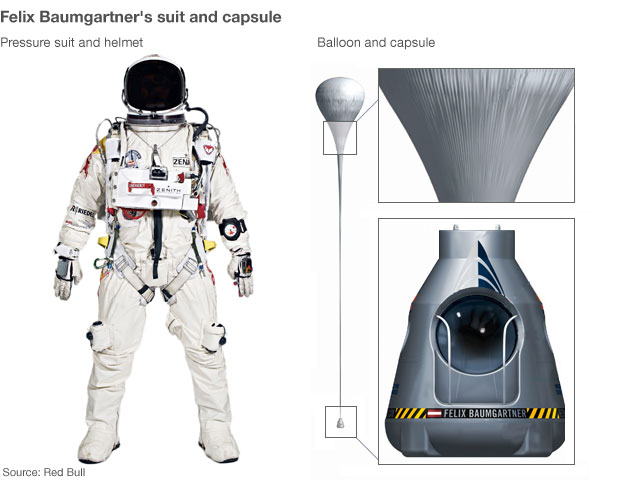A man on ledge, 23 miles up and no fear
- Published
- comments
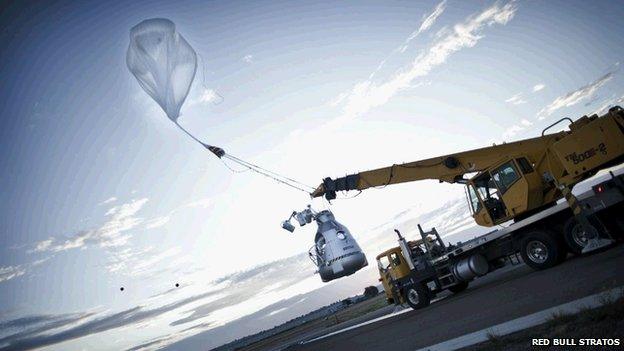
Launching the balloon involves a mobile crane chasing the rising envelope across the Roswell runway
They've dubbed it the "mission to the edge of space, external".
The pedants will no doubt point out that Felix Baumgartner's, external attempt to make the highest ever skydive from 120,000ft (36.5km) is nowhere near space; and of course, they'd be right - the so-called Karman line, external is judged to be at about 100km (328,000ft). But this kind of misses the point.
At the altitude the Austrian daredevil intends to leap out of his capsule, the air pressure is less than 2% of what it is at sea level. He'll be jumping into a near vacuum. He's all but in space.
It's been a long road for Baumgartner. He first discussed with his sponsors Red Bull the idea of breaking Col Joe Kittinger's, external 52-year-old parachute mark back in 2005.
Since then, he's had to battle technical and budgetary challenges to make it happen, calling on the expertise of a top-notch team - Kittinger included - to pull him through.
The 43-year-old now needs not so much as a fair wind but next to zero wind to launch his "monster balloon" and capsule. He should realise his dream in the coming days.
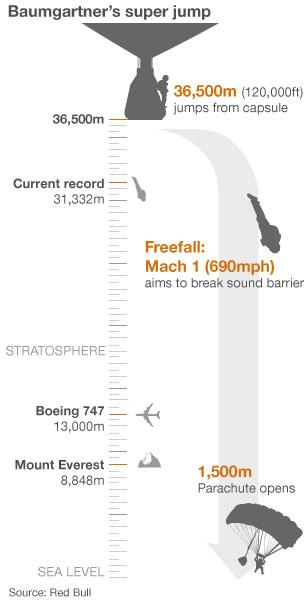
"It's enormously difficult to launch a balloon this big," team meteorologist Don Day told me.
"When it comes down to launching Felix, it'll all be about wind speed and wind direction. We need calm to 3mph, from the ground up to about 250m. If it's any more than that, our launch crane cannot keep up. But right now, Tuesday's looking good."
Baumgartner will try to break four records here in Roswell, New Mexico:
Highest ever parachute jump. On 16 August 1960, the US Air Force pilot Kittinger jumped from 102,800ft (31.3km). Baumgartner will use a helium balloon with 10 times the volume to get another 18,000ft (5.5km) higher into the sky. The polyethylene envelope is an extraordinary thing. It will be 55 storeys high on lift-off, and as wide as a football field when fully inflated in the stratosphere; but the membrane itself will be just 20 microns thick. Think of the plastic bag in which you collect your dry cleaning.
First human to break the sound barrier unaided by a vehicle. Kittinger reached 614mph (988km/h) - about Mach 0.9 - on his descent. Baumgartner is expected to achieve a speed in excess of 690mph (1,110km/h) within about 40 seconds of leaving his capsule. With so little atmosphere at 120,000ft, he will drop very rapidly. Enhanced GPS (he actually carries four sat-nav systems on his body) will tell mission control just how fast he is moving. Baumgartner himself should hear tones in his helmet when he builds up to, and goes beyond, Mach 1.
Longest freefall time. Another of Kittinger's records that stands to fall. He plunged through the atmosphere for just over four-and-a-half minutes. Baumgartner hopes to better that by at least a minute. Altogether, from jumping out of the capsule to putting his feet on the ground, the Austrian should take around 10 minutes to complete the journey back to Earth. The landing in the desert is likely to be several tens of kilometres from the lift-off location at Roswell airport.
Don Day: "It's only a few times a year that these balloons are launched"
Highest manned balloon flight: The type of balloon being used for the flight would normally be deployed in unmanned scientific experiments. Some infrared and microwave telescopes, for example, have to get above the water vapour in the atmosphere or they can't see the cosmos. But no human has flown this kind of balloon (835,000 cu m/29.5 million cu ft) to the target height. Baumgartner can only claim an unofficial record in this category, however. The Federation Aeronautique Internationale, external, which certifies all aeronautic records, insists the pilot must be in the balloon when it returns to Earth for the mark to be endorsed. Obviously, that doesn't fit with the current project.
"We can talk about records here if you want, but I'm more concerned about the science we're doing," Joe Kittinger told me.
"Felix will be wearing the next generation of full-pressure suit; future American astronauts will be wearing this kind of suit. Felix will demonstrate that it works at 125,000ft."
Heated sun visor
Oxygen supply hose
Main parachute handle
HD camera on each leg
Suit made of layered material
Mirror to check parachute
Altitude gauge
High altitude balloon: expands with altitude
Balloon made of plastic film 0.002cm thick
Frame attaches capsule to balloon
Sliding door to exit capsule
Foam insulated shell
There is no doubting that this is a dangerous endeavour. Two people who tried to better Kittinger's records in the 1960s lost their lives in the process.
Baumgartner has very sensibly built his project up step by step. He's jumped from 71,600ft (21.8km) and 97,100ft (29.6km), external - each time he's learned something new, especially how to frame his body in the dive (he'll adopt a delta position, tracking head down).
There has been a lot of discussion about what is likely to happen if and when he goes supersonic. What impact will the shock wave have passing over his body? Could it knock him into a spin, or even knock him unconscious? In fact, the project director Art Thompson thinks very little will happen. He says the skydiver might not even notice when he has gone Mach 1.
"Because we're breaking Mach above any significant air density, the pressure wave should be pretty negligible. But he could see something more significant when he comes out, but again he's likely to come out at about 92,000ft," he said. "We're figuring he'll be in Mach for 20-22 seconds."
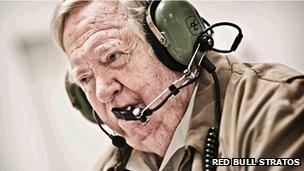
Kittinger, now in his 80s, is helping the Austrian to beat his 1960 records
A lot has been made, too, of the dangers inherent in operating beyond the Armstrong line. Go above 63,000ft (19km) and exposed human tissue will begin to swell; bodily fluids like saliva in mouth and water in the eyes will start to boil. Hence the need for that full-pressure suit.
Baumgartner will also be on a pure oxygen supply. There is insufficient O2 to gulp where he is going, and if there is a breach in his visor the hypoxia will put him in a deadly place.
I must say, looking at this mission, it is actually the first few thousand feet of the ascent that will have me most anxious on the day.
Baumgartner has to achieve a certain altitude (3,000ft/1km) before he can rely on the emergency abort system in his capsule.
If his fragile balloon were to tear and suddenly deflate below this height, there would not be enough time for the capsule to release itself and deploy a parachute.
And there's certainly no chance of the Austrian jumping free himself, not when he has to negotiate a narrow doorway wearing a pressure suit - however next-gen and flexible it might be.
"We start breathing when we get above 3,000ft," says Art Thompson.
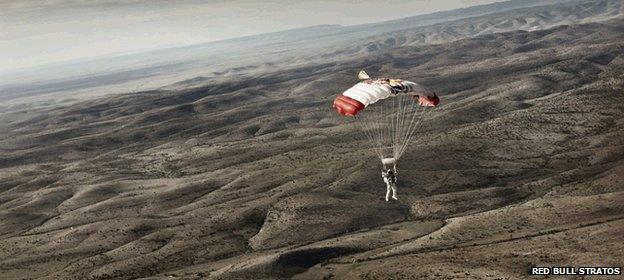
Baumgartner has made more than 2,000 skydives, but his next jump is an entirely different proposition
